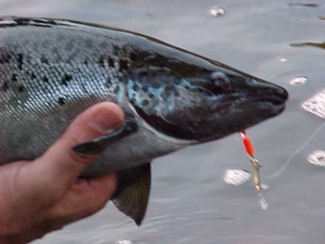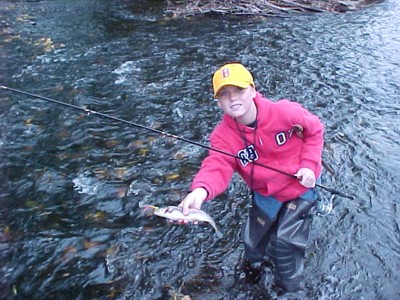Salmon and Steelhead Return to Lake Champlain’s Tributaries
| |
| by Mickey Maynard  Behold the natural beauty of a mature Atlantic salmon in late fall. | |
|
The many anglers who frequent Lake Champlain’s tributaries are looking forward to a couple of upcoming events. The fall Atlantic salmon spawning run that occurs from mid September through late October reunites the river with the salmon and trout fisherman after a long hot summer. Just as the salmon run begins to wane, steelhead begin returning to the rivers for their late fall, winter, and early spring occupation. It’s during the fall season that the mature landlocked Atlantic salmon (Salmo Salar), following its genetic imprint, returns to the tributary of its origin to spawn. To these landlocked salmon, Lake Champlain is their ocean. As part of their anadromous migratory life cycle these seasoned fish have spent the summer in the lake and will return to the river, often in sync with a significant rain. The aged salmon, most of which average from 3 to 6 pounds, will move to the upper reaches of the tributary in pairs, then locate and hold on a spawning nest known as a redd. Unlike Pacific salmon, most Atlantic salmon will return to the lake and are capable of spawning more than once. Atlantic Salmon were at one time native to the lake and very plentiful. On a 1776 map of Lake Champlain a salmon fishery is noted at the mouth of the Great Chazy River. Historical records show fish up to 20 pounds were once caught here in abundance. By the mid nineteenth century the native Atlantic salmon were gone. Research continues to determine weather these historic stocks were landlocked or sea run strains. Since the mid 1970s Atlantic salmon have been successfully stocked in Lake Champlain by New York and Vermont agencies. The three major tributaries stocked on the New York side are the Saranac, the AuSable, and the Bouquet Rivers. The Vermont Fish & Wildlife Department and the U.S. Fish & Wildlife Service also stock thousands of landlocked Atlantic salmon fry in the Lamoille and Winooski River watersheds. Don Lee, experienced fly fisherman and member of The Champlain Valley Chapter of Trout Unlimited, is the director of their “Salmon In The Classroom Program”. Mr. Lee, along with the help of other TU members, science teachers, and students, has been stocking thousands of Atlantic salmon in Lake Champlain tributaries over several years. Sounding very upbeat, Mr. Lee stated, “If the weather cooperates, we should see a good run this fall. There was a decent spring run with plenty of clean healthy salmon coming up into the tributaries.” Mr. Lee caught and released no less than seventeen Atlantic salmon this past spring and stresses the importance of freeing large females in the fall, “Natural reproduction in Lake Champlain’s salmon stocks is limited. Every female salmon that returns to spawn should be given that opportunity.” The fisherman should be aware that there are special regulations for stretches of some major Lake Champlain tributaries. Boat fishermen can take advantage of this fall run at the river mouths and in the deltas, but in late fall it’s the shore fisherman or those using waders to access the river who will make out best. During the usual low water conditions of fall, the hot spots are often quite easy to locate and target. The most obvious of holes or rips will likely hold the fish. If one is caught, give consideration to releasing it for its understandable contribution to the future of the fishery. In the lower reaches of some rivers spin fishermen will do well with small spoons and small rooster tail spinners in white, orange and red. Fly fishermen should have on hand plenty of egg imitations, streamers and nymphs. When accessing holes away from the shoreline, a good pair of waders with felt soles or spikes and a walking stick are suggested. Extreme caution should be used navigating about on the slippery algae covered rocks of the cool autumn river. For this reason a personal flotation device is also recommended. Polarized sunglasses will come in handy for determining depths of holes and sometimes for spotting fish. In fall salmon will be noticeably darker than those entering the river during their false run in spring. The spawning fish, especially the males, will usually have a pronounced hooked jaw. The spotted gill plates will often have beautiful dark purple and blue hues. It may also be distinguished from the trout by its pointed forked tail. Anglers will likely note lamprey scars on these mature fish. They have after all been chased around by the deadly parasites for several years by this point in their life cycle. These fish have really beaten the odds, yet another argument for their release. Due to recent treatments lamprey wounding rates are improving on Lake Champlain. If a thorough and cooperative program that treats all necessary tributaries is not completed in a timely manner we can expect the sea lamprey to continue to impact the future of our lake. | |
 A small steelhead is photographed at the scene of the catch and quickly released | |
As the salmon run winds down, a new fishing challenge emerges from the lake and continues through the winter months. The rainbow trout, or steelhead as it is officially known, is potamodromuous. They are genetically programmed to return to the rivers from late October through the winter months. Steelhead season is surely for the hearty, with most fish spawning in late winter to early spring. Steelhead are fewer in number than salmon because of limited stocking in Lake Champlain, but if timed right the fisherman may tie into one or more of these beautiful acrobatic fish making his time and efforts truly worthwhile. Baits for steelhead are very similar to those mentioned above for salmon. The fish however will be found in slightly different locations within the water flow. Look for steelhead in the faster water, directly in a riff or just at the base of it. They may also be located at the back or lower reaches of a pool on occasion. Steelhead will typically have a light body with dark spots and a pinkish band along their lateral line. A bonus brown trout may also be caught during these seasons. A trout’s tail is spotted, thicker, more rounded, and much less forked than that of an Atlantic salmon. The Atlantic salmon and trout seasons are open throughout the year on Lake Champlain and the lower portions of its tributaries. In both Vermont and New York there is a limit of two Atlantic salmon no less then 15 inches in length, and 3 trout no less than twelve inches long. The major New York tributaries of Lake Champlain also have special regulations to further protect their spawning brood. The angler should always be familiar with the regulations for the specific area of the tributary they plan on fishing. The steelhead fishery on Lake Champlain’s tributaries is a fragile one. To a lesser extent the Atlantic salmon fishery is as well. Consideration should always be given to release as many fish as possible. For bragging rights or potential records take along a camera and snap a quick shot of one of these rare beauties, but please, for the future of the fisheries, let most of them go. | |
| Back to the main page | |